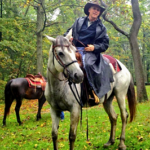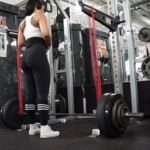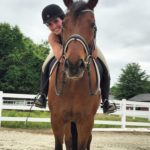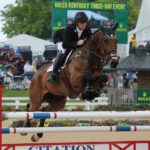
At the beginning of Day 2, the colts were each put in a different round pen from the day before. This time they would be worked for a total of two hours. The trainers had to be outside of the pens for some combination of another 20 minutes so the colts could rest.
Carryover and Firsts
John was able to walk right up to his quietly standing colt and give him lots of rubs and hugs. He spent a lot of time throughout the entire session handling and hugging his colt’s head, ears, and nose, getting him to relax, give to pressure, and accept that having a person do anything at all with his head was not only okay, but it was actually pleasurable and reassuring.
These colts had just come from Wyoming, where March is very much mid-winter, so they were still wearing their heavy winter coats. Chilly as it was by Tennessee standards, John knew it was pretty warm to this colt. With a lot of physical activity coming up, John didn’t want him to get too overheated, so he started currying and brushing him. This was a Road to the Horse first that really helped relax the colt. It also got a lot of wooly, sweaty, winter fur from the day before off the colt and onto the ground.
While he obviously enjoyed the grooming, John’s colt strenuously objected to protective front boots-also a Road to the Horse first. This took a lot of time and effort, but John quietly persisted until the boots were secure. John felt that this was an important safety provision for his colt.
John started picking up a hind foot, but the colt was still showing a great deal of fear, so he shifted to work on “spook in place” training. “You can’t expect a horse never to be afraid, but you can teach him to stand and face the thing he’s afraid of,” John explained.
He began this training by just saying, “Boo!” and barely waving his hands at the colt. When the colt didn’t move, he was rewarded with more rubs and hugs. John gradually progressed to bigger motions, each time rewarding the colt for standing still and watching. Eventually, he was able to shake a plastic tarp in the colt’s face while he just stared at him, obviously wondering what odd thing John might come up with next.
The colt was still tending to present his hindquarters to John, so he also attached a lariat to a burlap bag around the colt’s neck to teach him to turn and face John. The burlap distributed pressure so it wouldn’t hurt. Pain-aside from being wrong and unnecessary-is a distraction. John ended up wrapping the lariat completely around the horse’s body again, letting the colt quietly figure out how to walk out of the tangle.
This was a good point for a break.
Build Trust
Host Rick Lamb came over to chat and asked John if the colt was learning to trust him.
“He’s learning to trust me to be me,” John answered. “What is important to all horses is consistency,” he added. Always being firm but gentle, never losing his temper, insisting on a response to his cues but having a positive response be pleasant and well-rewarded was what was making an impression on John’s colt.
Returning to the pen, John worked on more sacking out with a saddle blanket. He brought out a tarp and flapped it around for more “spook in place” work. The colt began willingly coming forward to investigate things that had frightened him only the day before.
After the colt was saddled and bridled again, John reviewed the rope desensitization done the day before. The colt would still occasionally present his hindquarters, so John worked more on “hips over” cues from both sides.
Shoulder Control
Next, John started working on shoulder control. This involves important exercises that teach the horse to move his shoulder a specific direction away from the handler. This exercise was necessary to give John more control over where the colt was trying to place his body when he got nervous. Like the “hips over” cue, it’s always practiced with the horse moving.
Positioning his hand on the rein to give the same signal when he was in the saddle, John gave a “go forward” cue and shifted the colt’s balance to the opposite shoulder so it was natural for him to step away.
The colt started to freeze up when asked to go forward. Actually, he planted his feet so firmly to the ground that it looked like a derrick wouldn’t move him!
By this point, the colt was expressing less of a sentiment of “I’m afraid of everything here” and more of a sentiment of “I’m afraid because I don’t understand what I am supposed to do next.”
He reverted to trying to push into John rather than moving away from pressure. The most effective way of dealing with this is to take time to solidly establish shoulder control. Time is not a luxury this competition allows, but shoulder control is necessary for safety.
Tapping gently with a dressage whip, John reviewed a lot of “go forward” and “hips over” work. Although he began moving again, the colt was still not consistent.
After a good response, John gave the colt another break. He returned to the pen with a lariat in his hand. Tapping with the dressage whip was not proving effective, and too much pressure would be a harmful, negative approach. Neither fear nor pain was going to make the colt learn faster. He had responded well to the lariat during the early groundwork, so John went back to that.
He continued to send the colt forward. John used the lariat attached to the bridle then wrapped around the hindquarters to get the colt to give to pressure and move his hips over. When that was better established, John stepped into the stirrup, waggled the saddle around, mounted, and rubbed on the colt while he was up there. He then got on and off from both sides repeatedly, slapping the saddle and making noise.

Frozen Feet
While the mounting process went well, his colt froze up again when John asked him to go forward from the saddle. He simply did not connect the “go forward” cue from the ground to this new situation.
John tried “kissing” to the colt. He tried squeezing with both legs. He tried more vigorous kicking to get a startle response that would move the colt’s feet. He tried reinforcing the leg cues with his “noisy but easy” spurs (The rowels were well wrapped in elasticon so they didn’t cause any pain). He tried a gentle “popper” crop, one that makes a lot of noise, but inflicts no pain. After one tap with this, John could tell it would have no effect on his colt, so he threw it away.
The colt’s feet stayed frozen. Then the colt started swinging his neck back and forth toward John’s knees. “Once didn’t work. Twice would be useless,” John decided. Since the colt had solidly planted himself because he didn’t know what to do next, this could easily have turned into a wreck if he was pressured too hard. John got off and went back to the lariat from the ground. Every time the colt moved a foot or even shifted his weight forward, he got a reassuring rub on the ears as a reward.
This technique unlocked him and produced a nice free walk. When John remounted, the colt began to walk forward with pricked ears, but every time he got confused he froze up again. After the colt gave a few steps of trot, John got off to give him another break.
Steering the Tail
On re-entering the pen, John worked on picking up all four feet and reinforcing the “go forward” cue still more from the ground. When he re-mounted, the colt began walking forward more confidently under saddle. Then he started trotting and turning as John worked on “steering with the tail” for better control.
“Steering with the Tail” (see May 2009 issue, page 12) is John’s term for gaining control of the hindquarters when you’re in the saddle. The power generated from the horse’s hindquarters is the motor that drives the boat. Although it’s common to try to pull the nose around into the direction you want a horse to go, especially when working with a green colt, this does not give the rider any directional control. As John’s colt demonstrated so well, a horse can bend his head around to the rider’s knee and look him in the eye while galloping forward or going nowhere at all. It’s safer, more efficient, and more comfortable for both rider and colt to ride the whole horse in the direction you want to go.
It was, however, one more thing John had to teach in a very short time. Using the hindquarters for propulsion and steering required the colt to move forward reliably. He still froze up occasionally, but responded well to a gentle slap with the lariat as a reminder of the “go forward” cue. John began throwing the lariat over the colt’s head and looping it over the rump while he was in the saddle, then gave the colt another break.
Rick Lamb asked John if the colt was being stubborn.
“No,” said John genially. The crowd laughed.
“Surely he’s resisting?” queried Rick.
“No,” John said, just as genially. The crowd laughed again. “He just doesn’t understand. We can’t blame him. It’s the teacher’s job to teach.”
“So you’re saying it’s your fault?” asked Rick.
“No,” John said, still in the same tone. The crowd laughed louder. “You can’t judge right or wrong. You do things differently to get a different response.”

There wasn’t time to go into detail at that point, but this is an important concept. If someone says you’re doing something wrong or your horse is doing something wrong, you start mentally building a wall between yourself and the horse. This is our “people attitude” coming out. We frame the horse in our terms, not his, pointing fingers of blame. This has nothing to do with natural horsemanship and your horse doesn’t understand it. Since it accomplishes absolutely nothing, it’s better to just get on with trying a different approach.
“How are you going to free up his movement?” Rick asked.
“I don’t know,” John responded honestly. “I’ll just work with him.”
Actually, John was thinking very hard to figure something out on the spot that would be more effective at that particular moment with that particular colt. What the colt really needed was shorter lessons with more break time in between, but that wasn’t an option in this competition.
John went back to more groundwork, sending his colt over poles. The colt hesitated at the tarp and table. When he stopped, but looked interestedly at the tarp, John took the pressure away. When he tried to avoid it, the pressure was put back on. On the next attempt, he stopped at the tarp, but looked over at John. John stood quietly as the colt looked back at the tarp, walked over it, and came over to him for praise and petting.

John worked his colt more on the tarp, always kissing a “go forward” cue. He stopped him in the middle of the tarp and sent him forward again. He had him come to him from the tarp. He stopped him again on the tarp. He moved him around on the tarp, always in response to a “move your feet” cue.
He did the same with the box. This was a wooden structure, raised several inches but hollow underneath, recreating the sound of a bridge when the colt walked over it. When the colt put his front feet on the box, John took the pressure away. The colt went forward and stepped on the box. John sent him off. On. Off. On. He turned him around and sent him off the box again, always working on the “go forward” cue.
The colt trotted freely over the tarp and irregularly raised poles with decorative potted trees scattered around. John mounted and rode his colt at both a walk and trot over the poles, over the tarp and over the box. At this point, John got off the colt and gave him another break.
When he got back on, he continued work on going forward, shoulder control, and steering with the tail in the time remaining. The colt still occasionally tried to freeze up. As the clock counted down, John got off, unsaddled, took off the bridle, put a halter on, and took off the leg wraps. The last wrap came off with 30 seconds to spare!
Final Exam-The Obstacle Course
Each trainer would be allowed 35 minutes to bring his colt in, saddle him, prepare him in any way he needed to do the ridden tests, do as many of the obstacles as he could, and then do any freestyle demonstration he wished to show what else he had taught his colt.
John changed his sweaty shirt and, with a smile, said, “I’m glad Jody pushed me to work out!”
John shared his thoughts on the progress of his colt: “He doesn’t so much have fear now. It’s more like an attitude of ‘I’m going to do what I want to do when I want to do it.’ He still needs to be more solid on the ‘go forward’ cue.”
All the trainers said that it would have been best if the colts could have rested that night and continued the next day. The final test, however, had to be dealt with immediately. In the draw for go, Tommy Garland went first, John second, and Richard Winters third. The trainers, wearing microphones, were required to announce to the judges what they were going to be doing before performing the movements that were to be judged. This was to make it clear that the colt was responding to specific cues and not just turning, backing, trotting, or loping out of fear or evasion.
John used his microphone during the final test to give a very public clinic on what he was doing and why.
As he led his colt into the round pen, John emphasized, “He still has trouble understanding moving forward and giving to the bridle. He just needs more time.”
When he said, “Come over here a minute,” reinforced by a kissing sound, the colt came. “We worked hard on that because he was so afraid. If he walks up to me, it changes his mindset that I might hurt him. It helps overcome his fear.”

John saddled and bridled the colt, then led him out of the pen and around the arena. He made small adjustments to his movement and body position all the while to get him comfortable being controlled in the larger environment. The colt stood freely as he picked up the first two feet, but trotted off when he reached for a hind leg. “Not a big deal-it’s normal. It gives me an opportunity to work on having him come to me.” The colt promptly came on cue. All four feet were duly picked up.
Unlike in the round pen, where he stood quietly to be mounted, the big colt moved around during John’s mount in the open arena. This was an additional challenge as that stirrup was a considerable stretch from the ground for John. “Because he didn’t want to move forward in the round pen, we didn’t get to practice ‘go and stop’ or spend as much time on hindquarter control as he really needed.”
John’s colt then gave a lovely, free long trot under saddle. But from then on, every time the colt broke into a trot on his own, John used a “hips over” stop to reinforce that he was the one who determined what gait they would work and how fast they would go.
He began moving happily on a loose rein, letting John choose the gait. His back up was done straight, on a loose rein. The forward walk was also straight, with his head relaxed and the rein loose. John began a quiet trot to the right and began teaching the crowd about the importance of steering with the tail while he reinforced that.
Turning the colt back and forth, he trotted freely in both directions, followed by lopes in both directions, all the way around the arena. He backed twice more. John dismounted and mounted from the other side.
The crowd was starting to mutter about how quickly the clock was ticking down without John having tackled any of the obstacles. “Eleven minutes left, John!” the announcer reminded him.
“We’re fine,” John responded, with a smile.
John and his colt performed a 180-degree turn to the left and one to the right, then they headed for the first obstacle.
He trotted through the serpentine of raised poles on a loose rein. The colt crossed the tarp easily, with an almost visible “been there, done that!” attitude. He walked through the highest ends of the pinwheel, sorrel feet stepping high as he looked interestedly down at this newest odd thing. He crossed the ground poles and a pole up on bedding bales. He went over the cross poles on a loose rein. These were all similar to things he had faced in the round pen, but it wasn’t the fact that they were approximately familiar that was important. He had learned to steer and go forward no matter what was in front of him.
He willingly approached an upright lattice to let John retrieve a lariat from the top corner, obediently moved off a bit, stood while the rope was twirled over his head, and then quietly walked back to the lattice so John could replace the lariat. He did the log drag in both directions, both pulling it behind him and turning and standing as John pulled the log toward him. He even stood quietly in a “patience box” after all of this movement and commotion.
The final obstacle involved walking over the chalked bulls-eye rings and up to a newly uncovered “mystery obstacle,” which was revealed as a cage with two live and very active chickens in it. John’s big colt approached willingly, on a loose rein, and touched the cage with his nose.
Freestyle
For the freestyle portion of the test, John had the colt step up onto a cluttered box, at which point John dropped his feet from the stirrups and knelt in the saddle. The crowd gasped and held its breath. Was John Lyons, with two recently replaced knees, going to go for the iconic Road to the Horse salute of standing in the saddle and waving?
No. He laughed and waved.
He also dropped the reins and pulled on a slicker before querying the announcer, “Can I use another person to run at this horse and try to spook him?”
“No,” the announcer confirmed.
“Then I won’t do that,” John chuckled. He dismounted and did his best to spook the horse himself, flapping and waving the slicker. The colt just stood and looked at him. When John moved, so did the colt, always to face him.
John said, “See? I also taught him to ground tie!” Laughter from the crowd. “You don’t believe me?” He walked away from the colt, who continued to stand politely until he was told to move, at which point he happily came to John.
They left the arena with 22 seconds remaining.







